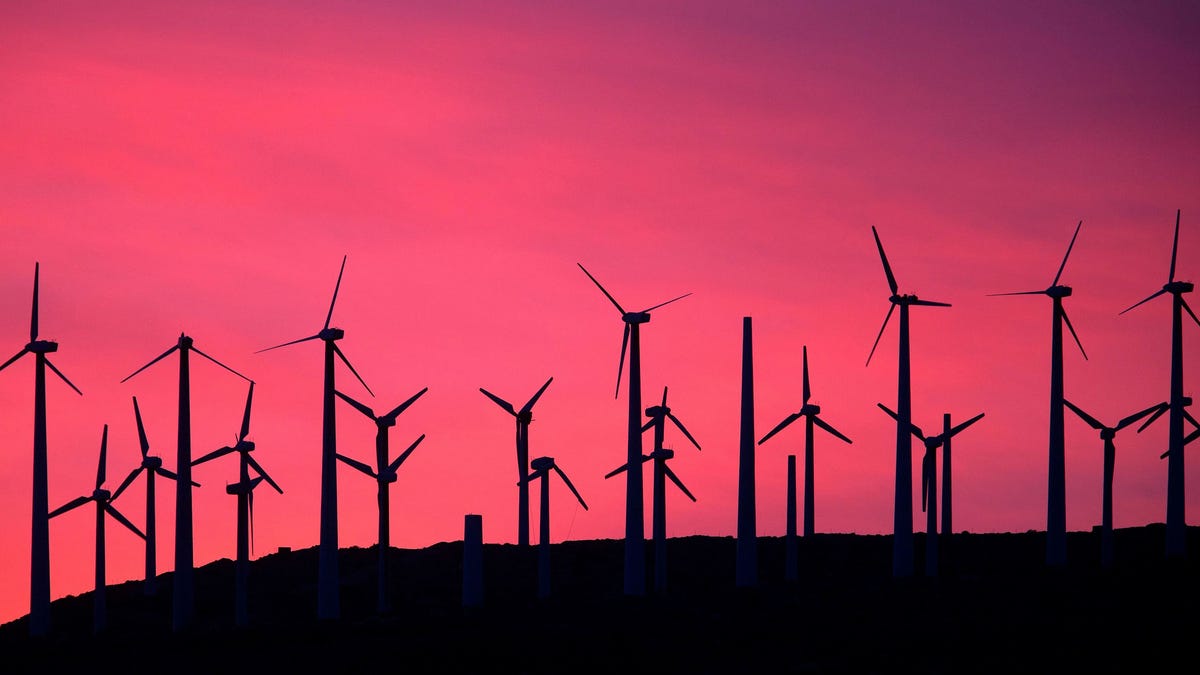We Already Have the Technology to Decarbonize U.S. Electricity - 5 minutes read
 Electric energy generating wind turbines are seen on a wind farm in the San Gorgonio Pass near Palm Springs, California Photo : David McNew ( Getty Images )
Electric energy generating wind turbines are seen on a wind farm in the San Gorgonio Pass near Palm Springs, California Photo : David McNew ( Getty Images )It’ll take a lot to transition the U.S. off fossil-based energy: money, political will, labor. But a new report shows it won’t take new technological innovation. The study, published in the journal Joule last week, shows U.S. electricity demand can be met with currently available carbon-free tech, like solar panels and wind turbines. And we can do it in just seven years.
Advertisement
Waiting for a unproven technology like next-generation nuclear power or carbon capture plants won’t save us from the climate crisis. The work needs to start now and the new study shows the tools are at the ready, and there’s no time to waste given, the study notes , “ the short time frame for power-system decarbonization and the long development times for new technologies and supply chains.”
Exxon Thinks You're Stupid In March, Exxon CEO Darren Woods whined that other oil companies drafting climate plans were simply Read more
Advertisement
The authors, both researchers at the Massachusetts Institute of Technology, modeled what it would take for utilities across the entire nation to move their electricity capacity to currently existing renewables, like solar, wind, and hydrothermal, backed up with short-term battery storage. They found that there’s no need to wait for any moonshot technologies . The whole plan could rely solely on proven technologies of which 1 gigawatt of capacity has already been deployed.
The findings also show that the best way to move the country to 100% carbon-free energy is to implement a nationwide plan, rather than taking a state-by-state or regional approach. This would allow the states to take advantage of electricity being generated outside of their immediate vicinity, thereby allowing developers to only build out clean power plants in the areas where they’re best suited. That would also reduce the need for storage. Though implementing the plan would require more transmission infrastructure, that would ultimately be cheaper than locally generated power and storage.
G/O Media may get a commission AirPods Pro $190 at Woot
Currently existing statewide decarbonization plans like renewable portfolio standards, and regional plans like multi-state utilities’ climate pledges, could be scaled up to meet the challenges of a clean energy transition. But the authors’ modeling shows that it’s cheaper to work across these divides.
“Inter-state coordination and transmission expansion reduce the system cost of electricity in a 100% renewable U. S. power system by 46% compared with a state-by-state approach, from $135 per megawatt hour to $73 per megawatt hour,” they write.
Advertisement
They propose having the federal government guide the creation of regional carbon-free grids. These could power their surrounding areas as well as send power to other parts of the country. For instance, wind turbines in Texas could produce enough power to fuel the Southeast while the mid-Atlantic could use solar power from sunnier Florida and hydropower from rivers that flow across Maine. The plan would also make all regions more resilie nt to changes in the weather that can affect generation .
“While the whole N ortheast might be cloudy or calm on a given day, that same day might be sunny in the southeast or windy in the midwest,” Patrick Brown, a postdoctoral researcher at the MIT Energy Initiative who co-authored the study, wrote in an email.
Advertisement
This strategy would also maximize intermittent energy sources (or ones that rely on particular environmental conditions to run, like the sun’s position or levels of windiness) by putting them in the places where they would run the best. And again, we have the technology to do this—we wouldn’t even need longer-lasting batteries than the ones we already have, though they might be nice.
“We definitely do not conclude that we should stop doing [research and development] on new low-carbon techs; if new storage or nuclear technologies are developed they could reduce costs even further,” Brown said . “The point is just that we shouldn’t wait for new techs, but should instead rapidly deploy wind and [solar] in conjunction with significant amounts of new transmission.”
Advertisement
The authors don’t claim implementing this plan would be easy. It will take a lot of work. But all of that work also means tens of millions of new jobs, and that’s a good thing, especially considering how many have been laid off by the failing fossil fuel industry and how many are struggling with unemployment amid the covid-19 pandemic. These existing forms of sustainable power have also proved resilient to economic hardship like the fallout of the covid-19 pandemic, which hit fossil-based energy industries hard. A recent report even found that by the end of 2020, global renewable power capacity will increase 7%.
Personally, I find the study comforting. I prefer knowing we have to fight for deploying existing technologies at a massive scale rather than banking it all on a riskier bet of something currently fictional to be created. And considering leading scientists’ warnings that we need to transform the entire global economy in 10 years to ward off catastrophic climate change and environmental degradation, we don’t really have time to waste.
Source: Gizmodo.com
Powered by NewsAPI.org